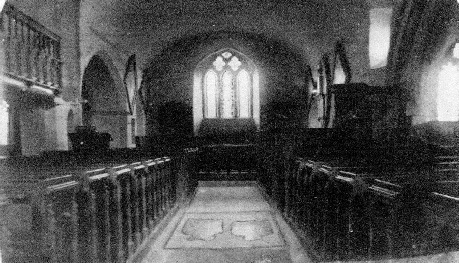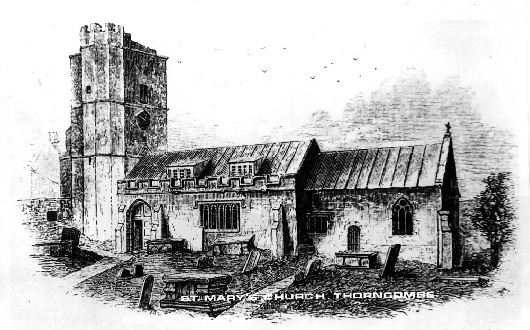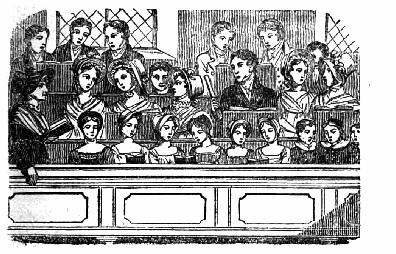






Thorncombe’s West Gallery Choir

Thorncombe’s medieval parish church, circa 1830
During the 18th century, purpose-
![]()

An early 19th century west gallery choir1
Thorncombe too had its West Gallery choir apparently accompanied by one instrument, a ‘bass vile' [a violin cello]. Whether or not the choir ‘knew its place’ is not recorded but it was paid for its services so was clearly valued. The church warden’s accounts record that the choir was paid 8s on 5 November 1784 and again on 23 December and Mr Hockey who was employed by the Vestry to teach at the charity school opposite the church, bought a copy of West Gallery composer Samuel Wakely of Bridport’s Five Anthems in 1833. In 1786 a new violincello and a book of instructions was sent from London. Robert Hawker who was paid for ‘righting the seats in the Gallery’ in 1792, may have played the violincello as he was reimbursed for five bass strings in 1805.2
While Pulman in his Book of the Axe mourns the demolition of the old church it was clearly damp, cold and difficult to maintain 4. The 1860 surveyor’s report was damning and his recommendation to replace old with new was accepted. In it he writes scathingly that, ‘At the west end of the Nave is an immense gallery projecting 18 foot into the church, cutting off the tower and western window. There is another hideous gallery which entirely covers the north aisle and only 6 feet 6 inches above the floor’.5 This was for the workhouse and Sunday school children who may have sung the treble part, as was customary in some churches. By 1840 church organs and congregational singing had replaced village choirs and bands.
EVE HIGGS, November 2018
For a more a detailed account and detailed supporting references see:
Higgs, E., ‘Thorncombe’s West Gallery Choir’
Devon & Cornwall Notes & Queries, Autumn 2018,vol. XLII, pt. IV, pp. 97-
REFERENCES
1. [L. Cameron], The Singing Gallery. By the Author of “Margaret Whyte”,&c (London, 1823), title page.
2. D[orset] [Hi]story [C]entre, PE/THO/CW/1/1-
3. Choral Public Domain Library at http://www2.cpdl.org accessed on 10 November 2018.
4. G. Pulman, The Book of the Axe: Containing a Piscatorial Description of that Stream
and Historical Sketches of all the Parishes and Remarkable Places Upon Its Banks,
(London,1875), pp. 445-
5. DHC D/RGB/LL31 Richard Grosvenor Bartelot Archive. Loose Papers and cuttings associated with D/RGB/LL31A, 1901.
| History of the Trust |
| Constitution of the Trust |
| Minutes of meetings |
| Archived Minutes |
| Obituaries |
| Contacts |
| Newsletter |
| Newsletter Archives |
| Past Events |
| Blackdown Walk Aug 2013 |
| Bluebell Walk May 2013 |
| Pollinator Survey June 2013 |
| Visiting new-born lambs 2013 |
| 2014 Christmas Sale |
| Trees |
| Commemorative Trees |
| Johnson's Wood |
| Geology and geography |
| Wildlife |
| Birds |
| Chard Junction Nature Reserve |
| Nature Reserve pictures |
| Butterflies |
| Butterfly surveys |
| Photo albums |
| Artists and writers |
| Footpaths |
| General |
| Poor relief |
| Houses |
| In the news |
| Industry |
| Pubs |
| Religion |
| Reminiscences |
| Schools |
| 17th and 18th centuries |
| Harry Banks |
| Pissarro |
| Hedge Dating |
| Once upon a Thorncombe Road |
| Thorncombe's Lost Roads & Hidden Holways |
| Thorncombe's History |
| First World War Thorncombe men |
| Thorncombe's Changing Boundaries |
| When Exeter was Down Thorncombe was a Town |
| Parish Poorhouse and Workhouses |
| The poor |
| Life in Thorncombe's Workhouse |
| Chard St Bakery & Forge |
| Holway Cottage |
| Forde Abbey |
| Gough's Barton |
| Holditch Court |
| Upperfold House |
| Sadborow Hall |
| Wayside |
| Thomas Place and The Terrace |
| Pinneys |
| 1 & 2 Church View Chard Street |
| Dodgy local ice-cream |
| Gribb arsenic poisoning |
| Industrial relics |
| Westford Mill |
| Thorncombe's Flax and Hemp Industries |
| Broomstick Weddings |
| Royal Oak |
| Golden House |
| St Mary's Church |
| Thorncombe's West Gallery Choir |
| Thorncombe's Chapels |
| Quakers |
| Commonwealth vicars |
| Who was William Bragge? |
| Holditch memories |
| St Mary's School |
| St Mary's School photos |
| Forgotten epidemic |
| Jacobites |
| Walk 1 |
| Walk 2 |
| Walk 3 |
| Walk 4 |
| Walk 5 |
| Walk 6 |
| Walk 7 |
| Walk 8 |
| A Village Walk. Walk 9 |
| Walk 10 |
| Rights of Way information |